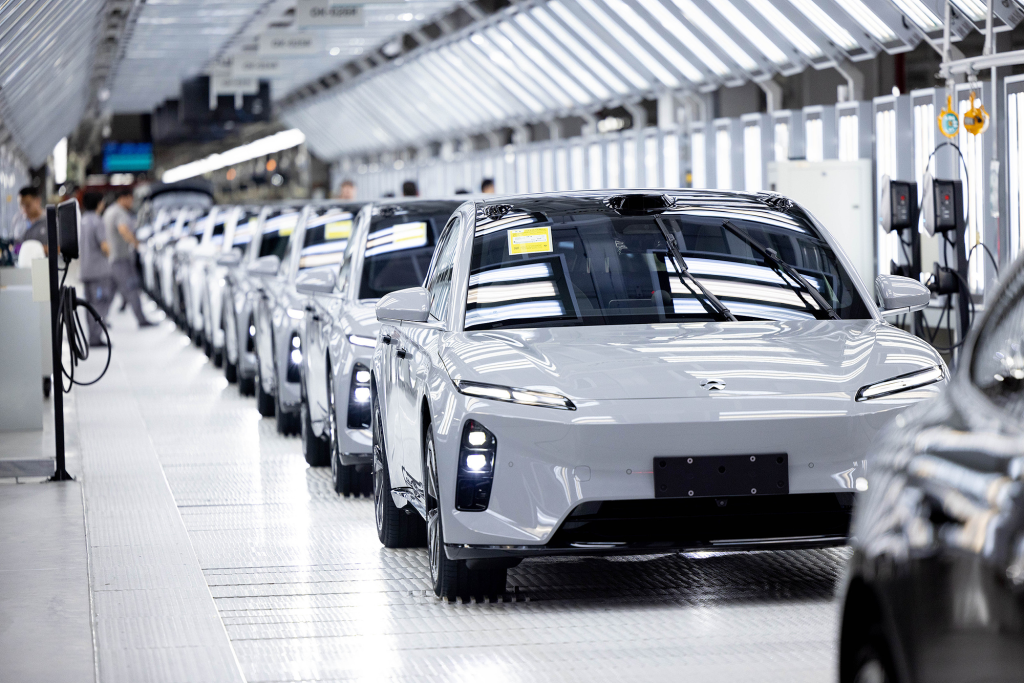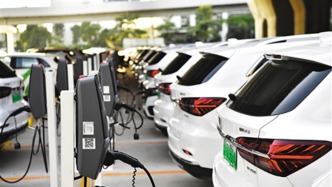
Facing the rapid rise of my country's new energy vehicle industry, Hefei is fully committed to its "leading industry" strategy, aiming to become a key player in the national and even global new energy vehicle landscape. During the 15th Five-Year Plan period, the industry will continue to expand and the competitive landscape will rapidly evolve, marking a new turning point for Hefei's new energy vehicle industry. Relying solely on internal strengths will no longer be enough to withstand this new round of competition. Finding the right position within the Yangtze River Delta integration strategy and integrating it into regional collaboration will be crucial to the future development of Hefei's new energy vehicle industry.
Hefei is attempting to adopt a more open approach, leveraging the Yangtze River Delta's strong manufacturing infrastructure and innovative resources to build a cross-regional collaborative ecosystem. From optimizing the industrial chain to tackling technological challenges, from market integration to infrastructure connectivity, Hefei's new energy vehicle industry is moving from "single-point breakthroughs" to "systemic collaboration," finding new growth drivers through regional integration.

July 1, 2025, Hefei, Anhui, NIO's intelligent production line. Visual China data map
Collaborative progress: building a new pattern of new energy vehicle industry chain
In the new energy vehicle industry, Hefei, leveraging its dual strengths in vehicle manufacturing and power batteries, is becoming a key growth engine in the Yangtze River Delta region. However, facing increasingly fierce market competition, a single breakthrough is no longer sufficient to sustain high-quality development. To achieve the transition from a "manufacturing powerhouse" to an "industrial hub," Hefei must deeply integrate into the Yangtze River Delta and build a synergistic, integrated regional industrial chain.
1. Enhance the resilience of the industrial chain
Hefei's new energy vehicle industry has a clear comparative advantage in vehicle manufacturing. Going forward, we should actively promote industrial consolidation by encouraging mergers and reorganizations among Hefei's leading vehicle manufacturers to increase the concentration of these companies. We should also actively promote close cooperation between vehicle manufacturers and upstream and downstream parts companies, establish an industry chain coordination mechanism that shares benefits and risks, and build a more resilient industrial collaboration network.
Within the Yangtze River Delta region, Hefei needs to leverage its fundamental strengths in vehicle manufacturing and battery technology to proactively connect with innovative resources from other provinces and cities. This includes collaborating with Shanghai on intelligent driving, vehicle networking, and automotive-grade chip development. It also aims to establish a more stable strategic partnership with Jiangsu in the supply of core components like power batteries and drive motors, ensuring supply security in key links. Leveraging Zhejiang's strengths in precision manufacturing and automotive electronics, Hefei will promote the production of high-end components and achieve an efficient connection between vehicles and components. Through these cross-regional collaborations, Hefei can effectively mitigate supply chain risks and enhance the resilience and flexibility of its industrial chain.
2. Filling key shortcomings
Despite a solid industrial foundation, Hefei still has shortcomings in key areas such as automotive-grade chips, intelligent driving systems, and lightweight materials. To address this, Hefei should improve its industrial structure through a "introduction + co-construction" approach.
In the future, Hefei will, on the one hand, enhance its own efforts in attracting investment and cultivating industries, and focus on strengthening cooperation with cities in the Yangtze River Delta region with a high degree of parts concentration but weak development of complete vehicles, such as Suzhou, Ningbo, Changzhou, etc., to introduce their leading high-end parts companies to settle in Hefei or set up production bases to strengthen industrial chain integration.
On the other hand, Hefei should also provide more resources, government services, and scientific and technological innovation elements to support cross-regional co-development, gradually forming a complementary structure of "Hefei complete vehicles + Yangtze River Delta parts." For example, Hefei should jointly build an intelligent driving and automotive-grade chip R&D platform with Shanghai; strengthen innovative cooperation with Jiangsu in new materials and power semiconductors; and attract Zhejiang smart cockpit and in-vehicle software companies to establish R&D or production bases in Hefei. Furthermore, Hefei can leverage the China Merchants Automotive Research and Development Vehicle Testing Base to lead the development of a new energy vehicle testing and certification system in the Yangtze River Delta. By integrating Shanghai's standard development efforts with Jiangsu and Zhejiang's equipment manufacturing, Hefei can establish a unified testing and certification platform, enhancing the region's voice in international standard setting.
3. Promote the extension and expansion of the industrial chain
In terms of industrial expansion, Hefei has a natural advantage in battery recycling and expanding its application scenarios. Leveraging leading local enterprises, Hefei can spearhead the development of a Yangtze River Delta battery recycling and cascade utilization center, collaborate with Jiangsu and Zhejiang provinces on recycling processes and resource regeneration, and leverage Shanghai's international platform to achieve standardization and policy mutual recognition.
At the same time, Hefei should actively integrate into the Yangtze River Delta aftermarket network and build a comprehensive service platform for the region. Interconnecting with Shanghai's aftermarket centers and the parts and maintenance networks of Jiangsu and Zhejiang, Hefei can promote unified after-sales service standards and mutual recognition of systems, and establish a cross-city consumer service platform. In the future, as Hefei deepens its efforts to build a demonstration zone for intelligent connected vehicles alongside Shanghai, Jiangsu, and Zhejiang, new scenarios such as self-driving taxis, smart public transportation, and smart logistics will continue to expand. Hefei is expected to achieve breakthroughs across the entire supply chain, from manufacturing to application.
Innovation-driven: Creating a new engine for technological collaboration in the Yangtze River Delta
Core technologies are the key to competition in the new energy vehicle industry. Hefei should leverage its advantages in scientific research and industrial clusters, drawing on research institutes and leading enterprises in Shanghai, Jiangsu, and Zhejiang to form an innovation system characterized by "division of labor, collaboration, and joint research," thereby boosting the region's overall innovation capabilities.
1. Improve the innovation chain and R&D system
Hefei can leverage the research strengths of research institutes such as the University of Science and Technology of China, as well as the technological expertise of leading companies like Jinghe Integrated Circuit, NIO, and BYD Semiconductor, to lead the development of the Anhui New Energy Vehicle Industry Innovation Consortium and collaborate with Nanjing, Hangzhou, and Shanghai to build the "Yangtze River Delta New Energy Vehicle R&D Innovation Center." This center will integrate basic research, technological breakthroughs, research application, and test verification, focusing on key technology areas such as power batteries, electric drives, and high-precision sensors. Bringing together scientific research expertise from Shanghai, Jiangsu, and Zhejiang, the center will prioritize breakthroughs in key areas such as power batteries, automotive-grade chips, intelligent driving, and vehicle networking.
At the same time, we should continue to promote the "two-heart creation" of the Anhui Hefei and Shanghai Zhangjiang Comprehensive National Science Center, and jointly build a high-level national laboratory system; support innovation platforms such as "USTC Silicon Valley" and "China Sound Valley" to carry out joint research and development with new energy vehicle companies in Jiangsu, Zhejiang and Shanghai; promote the sharing of innovation resources in the G60 Science and Technology Innovation Corridor, and realize the dual-wheel drive of "science and technology innovation + industry".
2. Improve cross- regional research mechanisms
To overcome bottlenecks, a collaborative mechanism for tackling key technologies for new energy vehicles could be established within the Yangtze River Delta region. This would clearly define Hefei as the leader in power battery and chip technology, Shanghai as the focus on artificial intelligence and software systems, Jiangsu as the primary focus on materials science, and Zhejiang as the bolstering of manufacturing processes. By jointly undertaking major national projects and building cross-regional demonstration projects, a regional science and technology innovation network featuring complementary resources and joint progress in tackling key issues could be formed.
3. Strengthen regional exchanges and achievement transformation mechanisms
To implement innovative achievements, Hefei should take the lead in establishing a regular cross-regional dialogue and exchange mechanism. Through multi-dimensional channels such as intergovernmental consultations, business forums, and university collaboration, we should promote the sharing of information, technology, policies, and market resources, as well as the exchange of experiences. Relying on digital platforms, we should build a "Yangtze River Delta New Energy Vehicle Industry Integrated Data Center" to achieve efficient integration of R&D data, technological achievements, and industrial resources.
At the same time, we should actively build a scientific and technological achievement transformation system in the Yangtze River Delta, take the lead in establishing a unified technology market collaboration platform, work together to build the Yangtze River Delta National Science and Technology Achievement Transfer and Transformation Demonstration Zone Alliance, promote the interconnection of information resources such as achievement information, technical needs, and service agencies, accelerate the cross-regional transformation and incubation of scientific and technological achievements, and continuously promote the deep integration of the innovation chain and the industrial chain.
Win the market through collaboration and jointly open up new development space
Competition in the new energy vehicle industry hinges not only on technology but also on the market. If Hefei is to secure a higher position in the national and even global industrial landscape, it must actively integrate into the integrated Yangtze River Delta market through differentiated strategies and cross-regional collaboration, seeking greater space for sustainable development.
1. Differentiated market layout
Currently, Hefei's new energy vehicle companies have a competitive advantage in the low- and mid-range markets, but still have room for improvement in the mid- and high-end markets. Therefore, differentiated market entry strategies should be developed based on factors such as the economic levels and consumer habits of different cities in the Yangtze River Delta. In international metropolises such as Shanghai, Nanjing, and Hangzhou, they should focus on high-end smart models, collaborating with companies like SAIC and NIO to develop new models to enhance their brand image and command premium prices. In economically developed cities like Jiangsu and Zhejiang, which prioritize cost-effectiveness, they should launch high-quality, affordable new energy vehicles to increase market penetration. Within Anhui Province, they should consolidate their existing foundation and focus on meeting the vehicle needs of families and public service sectors, thus forming a multi-tiered market layout.
2. Promote regional market connectivity
Co-organize new energy vehicle exhibitions, forums and roadshows with Shanghai, Nanjing, Hangzhou and other places to build a joint brand promotion mechanism in the Yangtze River Delta region and expand overall influence.
Promote cross-regional sales and service system coordination. For example, car companies such as NIO and Anhui Volkswagen can set up sales and service centers in Jiangsu and Zhejiang, while Shanghai's shared car and online car-hailing platforms can purchase more new energy vehicle models produced in Hefei.
In the field of public services, Hefei can work with cities in Shanghai, Jiangsu and Zhejiang to promote cross-city operations of new energy vehicles in taxis, buses, sanitation and logistics vehicles, unify vehicle procurement standards, share operation and maintenance systems, and mutually recognized charging networks, so as to achieve a coordinated reduction in operating costs and a simultaneous increase in market recognition.
For overseas markets, we will encourage new energy vehicle companies in the Yangtze River Delta to "go overseas in groups", jointly participate in international auto shows and market development, establish the "Yangtze River Delta New Energy Vehicle Export Shipping Center" with Shanghai Port, Ningbo-Zhoushan Port and Suzhou Port as the core, and promote Chery, JAC, SAIC, Geely and other companies to form the "Yangtze River Delta Automobile Export Alliance" to share overseas channels and market information, and continuously enhance the status of regional brands in the global new energy vehicle industry chain.
Vehicle-Road-Cloud Integration: Building a Smart Mobility Infrastructure Network
Infrastructure is the foundation for the sustainable development of new energy vehicles. Hefei should build on its strengths and drive the Yangtze River Delta region to achieve deep collaboration among vehicles, roads, and the cloud.
1. Build an interconnected charging and swapping network
Hefei should leverage its early-mover advantage in public charging and battery swapping infrastructure to lead the effort in establishing unified charging facility standards and certification systems across the Yangtze River Delta region. Through intergovernmental collaboration and the development of independent third-party platforms, leading charging operators, power companies, and OEMs from Shanghai, Suzhou, Hangzhou, and other regions should be encouraged to participate in building a regional charging service network that is "co-built, co-managed, and shared."
In the future, we should promote a unified payment system and authentication mechanism. Through government collaboration and linkage with third-party platforms, we should attract the participation of charging operators and power companies in Shanghai, Suzhou, Hangzhou, and other cities, and gradually achieve plug-and-play charging across cities and mutual recognition of fee settlement. Hefei can also leverage the capabilities of the Anhui power grid and collaborate with Jiangsu and Zhejiang provinces on power dispatch and load management to avoid "charging islands" and ensure regional energy security.
2. Accelerate the development of intelligent road traffic systems
Hefei has already begun developing intelligent connected vehicle demonstration zones in Baohe District and other areas, serving as key testing grounds for vehicle-road collaboration in the Yangtze River Delta. Future collaboration with the connected vehicle technology R&D platform in Shanghai's Zhangjiang District and the automotive sensor and communication module industry clusters in Suzhou and Hangzhou will enable joint efforts to promote full coverage of 5G-V2X and other vehicle communication networks, fostering low-latency, highly reliable connected vehicle services.
At the same time, Hefei should collaborate with Shanghai, Jiangsu, and Zhejiang to promote cross-regional traffic data interoperability, build a unified intelligent traffic management platform, and improve signal dispatching and road operation efficiency. Leveraging the experience of the Hefei-Ningbo Smart Expressway pilot program, further coordination can be achieved in developing smart expressway standards and data platforms to create a blueprint for cross-provincial smart transportation. Sensing equipment, vehicle-to-vehicle communication infrastructure, and big data analysis systems should be deployed simultaneously along key roads to enable cross-regional traffic information collection, road condition warnings, and service sharing. This will support the cross-city operation and dynamic dispatch of intelligent driving vehicles within the Yangtze River Delta, providing foundational support for the implementation of autonomous driving within the region.
Policy mechanisms and factor guarantees: a solid foundation for the coordinated development of the Yangtze River Delta
1. Establish a comprehensive coordination mechanism for the Yangtze River Delta
It is recommended to set up a "Yangtze River Delta New Energy Vehicle Coordination Group" under the direct guidance of the Yangtze River Delta Regional Integration Development Leading Group to coordinate industrial policies, technological breakthroughs, industrial chain optimization, infrastructure interconnection, talent training and pilot demonstrations.
The coordination group can hold joint meetings regularly to unify the planning of industrial layout and key tasks, clarify the positioning and division of labor of various regions in the new energy vehicle industry chain, and avoid homogeneous competition.
At the same time, cross-regional supporting policies can be introduced, such as vehicle purchase subsidies, tax incentives, financial support, and subsidies for charging infrastructure construction, to create a policy synergy and increase regional market size and consumer willingness. A joint supervision and performance evaluation mechanism should be established to ensure policy implementation, optimize policy improvements, and promote the sustainable and healthy development of the industry.
2. Improve the talent introduction and guarantee mechanism
Hefei should take the lead in building a collaborative talent system for new energy vehicles in the Yangtze River Delta. Leveraging local universities, research institutions, and businesses, Hefei should collaborate with universities in Shanghai, Nanjing, Hangzhou, and other regions to launch a master's program in new energy vehicle engineering, cultivating senior engineers with backgrounds in electrification, intelligence, and connectivity. This initiative should also foster deeper collaboration between universities and businesses, including internships, on-demand training, contract-based training, and skills competitions, to establish a comprehensive talent development system for high-end engineers, R&D personnel, and front-line technical workers.
Establish a Yangtze River Delta New Energy Vehicle Talent Development Alliance to regularly conduct training, seminars, and forums to promote cross-regional talent mobility and experience exchange. Improve supporting housing, education, and healthcare, and offer incentives for high-level talent and business start-up initiatives to attract top domestic and international talent, thereby boosting the overall talent pool in the Yangtze River Delta industry.
3. Improve the financial services support system
Hefei can take the lead in establishing the Yangtze River Delta New Energy Vehicle Industry Investment Fund to attract social capital participation, form a diversified investment and financing pattern guided by the government and operated by the market, and provide financial support for industrial innovation, market expansion and technological upgrading.
At the same time, new energy vehicle companies are encouraged to raise funds through multiple channels, including equity financing, bond issuance, and asset securitization. Key companies will be supported in going public and undergoing mergers and acquisitions to achieve industrial resource integration and large-scale development. A "green channel" for listing of new energy companies in the Yangtze River Delta can be established, leveraging platforms such as the Shanghai Stock Exchange's Science and Technology Innovation Board and the Jiangsu Equity Exchange Center. This will streamline the approval process for cross-provincial mergers and acquisitions by new energy vehicle companies.
Financial institutions in the Yangtze River Delta can jointly promote innovation in supply chain finance and green finance, use big data and blockchain technology to optimize credit assessment and risk management, and provide financial support for the high-quality development of the regional new energy vehicle industry.
From "Made in Hefei" to "Yangtze River Delta Collaboration", the new energy vehicle industry is becoming a typical example of regional integrated development.
( Authors Ni Zeqiang, Yang Geng, and Ren Tianhao are all from the School of Management, Hefei University )


